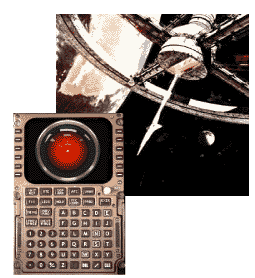 |
||||||||
| Issue Number 281 |
February
2002
|
|||||||
|
P.O. Box 189, Moffett Field, CA 94035-0189 |
||||||||
|
|
||||||||
 |
||||||||
| Issue Number 281 |
February
2002
|
|||||||
|
P.O. Box 189, Moffett Field, CA 94035-0189 |
||||||||
|
|
||||||||

 The
benefits of cockpit automation in the operation of complex aircraft
have been well established. However, incidents continue to occur in
which flight crew management of one or more aspects of the automated
system is implicated. NASA/ASRS receives several reports each day
on anomalies associated with the Flight Management Computer (FMC).
The majority of these involve flight crew programming errors or a
lack of familiarity with FMC response to certain inputs. In an effort
to increase awareness of these errors, all of the reports discussed
in this issue of Callback are related to the most common FMC problems
reported to ASRS.
The
benefits of cockpit automation in the operation of complex aircraft
have been well established. However, incidents continue to occur in
which flight crew management of one or more aspects of the automated
system is implicated. NASA/ASRS receives several reports each day
on anomalies associated with the Flight Management Computer (FMC).
The majority of these involve flight crew programming errors or a
lack of familiarity with FMC response to certain inputs. In an effort
to increase awareness of these errors, all of the reports discussed
in this issue of Callback are related to the most common FMC problems
reported to ASRS.
![]()
This B737-800 crew detailed the consequences of failing to compare the flight plan route with the FMC Legs Page(s) data. Their experience was typical of many incidents reported to ASRS in which fixes either were not entered, or were "dropped" by the computer.
![]()
When a runway entered in the FMC is changed, the computer may drop out previous altitude restrictions. Changing any portion of a route in the FMC requires that the Legs Page(s) be checked to ensure that each waypoint and crossing restriction is correct. Two A320 crews and a B757 crew related their experiences to ASRS.
![]()
This MD90 crew learned that a runway change on departure can also cause the FMC to drop previously programmed routing.
![]()
In this report to ASRS, a B737-300 Captain demonstrated how good airmanship, which includes situational awareness, should be used in conjunction with automation.
A few quotes from the speech-enabled HAL 9000 onboard computer, featured in the Stanley Kubrick film 2001: A Space Odyssey, have been added as a reminder that human monitoring of automated flight systems is still required.
FL250: A Descent Odyssey
HAL: "Good evening... Everything is running smoothly."
 We
were at FL250 when Center cleared us to cross 30 miles west of ABC
VOR at 17,000 feet. The First Officer was flying on autopilot and
dialed in 17,000 feet in the altitude alerter then started programming
the FMC for the crossing restriction. I dialed in ABC on my VOR. Realizing
that we were fairly close to the idle power descent profile, I mentioned
this and selected Level Change. There was no intersection for the
crossing point so the First Officer had to build it, which takes time.
We
were at FL250 when Center cleared us to cross 30 miles west of ABC
VOR at 17,000 feet. The First Officer was flying on autopilot and
dialed in 17,000 feet in the altitude alerter then started programming
the FMC for the crossing restriction. I dialed in ABC on my VOR. Realizing
that we were fairly close to the idle power descent profile, I mentioned
this and selected Level Change. There was no intersection for the
crossing point so the First Officer had to build it, which takes time.
HAL: "I am putting myself to the fullest possible use, which is all that any conscious entity can do."
When the FMC finished thinking, it indicated that we were well below profile, so the First Officer hit VNAV which brought the descent back to 1000 fpm. That didn't make sense so I looked at the descent profile which verified what the First Officer had indicated. My VOR readout and the FMC did not agree, but I did not realize what was wrong at the time. I advised [the First Officer] that we were pretty close to the profile and once again selected Level Change. The First Officer was as confused as I was, but accepted the idle power descent profile... I realized in hindsight that he had no idea what I was basing my concern on. Passing FL200, I concluded that we would make the restriction based on the VOR information, but that it would be close. I called 10 miles which probably caused more confusion since the FMC indicated that we were significantly farther away. In deference to me, the First Officer increased the descent speed up to our previously assigned limit speed to hasten the descent... We crossed the restriction point at 17,400 feet... We were very close but not perfect. It took a while, but I finally realized that the First Officer had constructed the crossing waypoint correctly but had inserted it after the next intersection instead of before it. The FMC assumed that we were going to fly to the pre-existing intersection then back to the crossing point, which added a number of flying miles to the crossing point and led to the descent profile being in error. Unfortunately the error was caused by a reliance on modern technology which is wonderful but relies upon correct inputs.
HAL: "This sort of thing has cropped up before and it has always been attributable to human error... I think you ought to calm down...and think things over."
After the flight, we had an extensive conversation in which I showed the First Officer how to verify that constructed intersections are inserted correctly. We also discussed why, when there is any confusion as to who is correct, the appropriate solution is to follow the most conservative course of action. If it turns out that it was unnecessary and we are way early on the crossing profile, nothing is lost but a small amount of fuel. Controllers could help minimize this potential problem when dealing with modern FMC-equipped aircraft by giving crossing restrictions based on predefined intersections that would likely already be in our database. Any time you have to construct a crossing point, it takes a lot more time and introduces a significant opportunity for error. If there is any doubt, take the most conservative of all the options and do not hesitate to ask ATC for help.
HAL: "I feel much better now."
While all of these reports deal with Airline Crew or ATC Controller issues, the need to maintain situational awareness applies to all pilots. Overreliance on any technology can lead to complacency. As with all aids to flight and navigation, from coupled autopilots to hand-held GPS units, system knowledge and situational awareness are key factors in safe airmanship.
|
ASRS Recently Issued Alerts On...
|
|---|
| MD80 galley door skin damage |
| DA20-C1 fuel contamination incident |
| Western airport runway incursion incident |
| Aircraft cleared for visual approach in IMC |
| CFM-56 weather-related fan blade damage |
|
January
2003 Report Intake
|
|
|---|---|
| Air Carrier/Air Taxi Pilots |
2,053
|
| General Aviation Pilots |
583
|
| Controllers |
17
|
| Cabin/Mechanics/Military/Other |
129
|
| TOTAL |
2,782
|